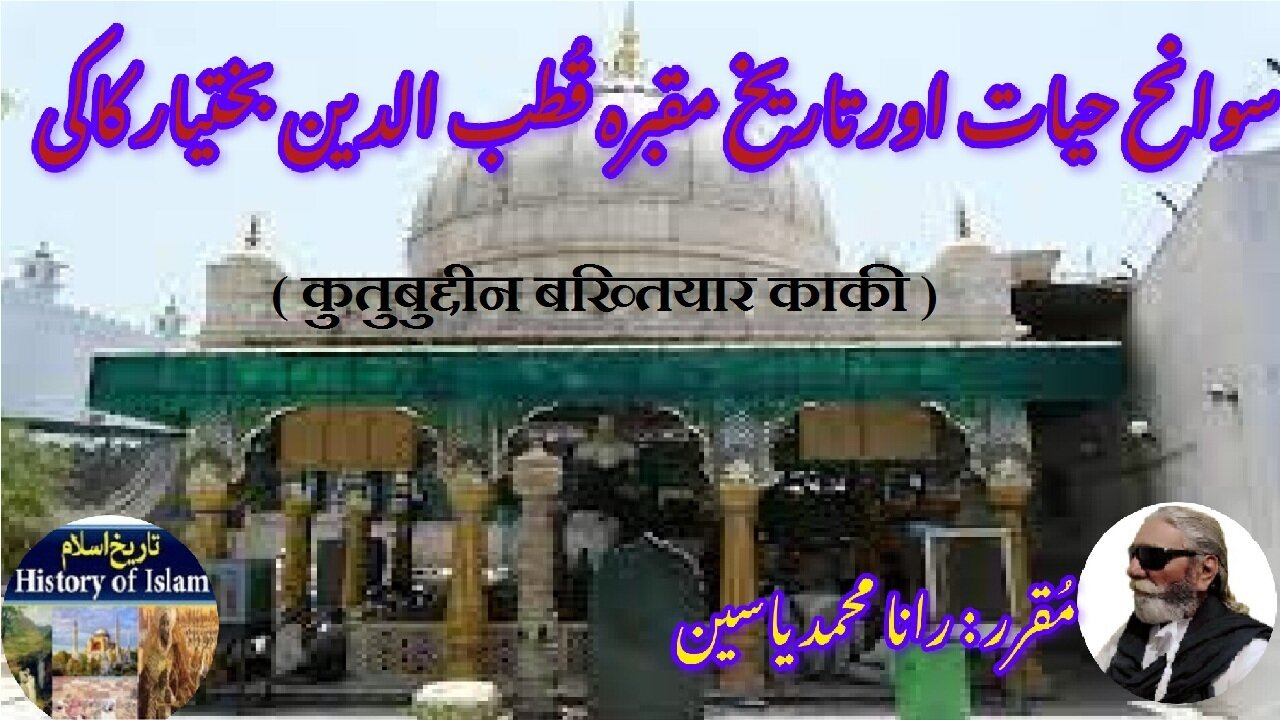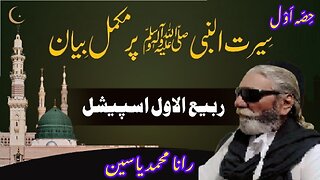Premium Only Content

Qutb-ud-Din Bakhtiar Kaki | कुतुबुद्दीन बख्तियार काकी | سوانح حیات، قطب الدین بختیار کاکی اور مزار
@islamichistory813 #biography #qutbuddin #bakhtiar #kaki #sufisaint #culturalheritage #biography #islamicmysticism #islamic #philosophy #shrine #historical #figures
Biography of Qutb-ud-Din Bakhtiar Kaki and the history of his shrine
Dekhti Aankhooon aur sountay kaanoon ko Asslamoalaikum, sisters, brothers friends and elders, in informative series videos of Islamic ascolars, sufisaints, cultural heritages, islamic philosophys, islamic mysticisms and historical figures. today we are describing biography of Qutb-ud-Din Bakhtiar Kaki and the history of his shrine.
Khwaja Syed Muhammad Bakhtiar Hussaini, also known as Qutb-ud-Din Bakhtiar Kaki, was born in 1173 in the city of Nishapur, which is located in present-day Iran. He was a prominent Sunni Muslim Sufi saint, theologian, and scholar of the Chishti order in Delhi, India, and remains one of the most revered figures in the Sufi tradition. His life and legacy have left an indelible mark on the spiritual landscape of South Asia, particularly in the development and spread of Sufism within the Indian subcontinent. A significant aspect of Bakhtiar Kaki’s life was his deep commitment to the principles of love, service, and devotion to God, which became central to his teachings and spiritual philosophy. His arrival in India and subsequent settlement in Delhi helped lay the foundation for the flourishing of the Chishti Sufi order in the region, which would later play a crucial role in the spread of Islamic mysticism in South Asia.
Bakhtiar Kaki's early years were spent under the guidance of his father, who was also a pious and respected individual. His education in Islamic sciences, particularly Sufism, was an essential part of his upbringing, and he soon gained a reputation for his scholarly abilities. In his youth, Bakhtiar Kaki traveled extensively, seeking spiritual knowledge from various esteemed Sufi masters of the time. His most significant spiritual mentor was the great Sufi saint Khwaja Usman Harooni, who played a vital role in shaping his understanding of the Sufi path. It was under the guidance of Khwaja Usman Harooni that Bakhtiar Kaki began to deepen his understanding of the inner dimensions of Islam and the mystical practices that would later define his teachings. Through his rigorous training and intense spiritual practice, Bakhtiar Kaki became a renowned figure in the Sufi community.
In the early 13th century, Bakhtiar Kaki arrived in India, a region already experiencing profound religious and cultural changes due to the spread of Islam. It was in Delhi, the heart of the Delhi Sultanate, that Bakhtiar Kaki settled and began to teach and spread the message of Sufism. The Chishti order, known for its emphasis on love, humility, and selfless service to humanity, found a fertile ground for its expansion in the culturally diverse environment of Delhi. Bakhtiar Kaki’s message resonated with the people of Delhi, and his popularity quickly grew. His teachings emphasized the importance of inner purity, devotion to God, and the cultivation of divine love as the path to spiritual realization. His Sufi practices, which included dhikr (remembrance of God), meditation, and self-discipline, attracted a large following of disciples who were drawn to his compassionate and simple approach to spirituality.
As a key figure in the Chishti order, Bakhtiar Kaki was instrumental in shaping the development of Sufi thought and practice in India. The Chishti order, with its focus on personal piety, service, and love for humanity, became a major force in the spiritual and cultural life of South Asia. Bakhtiar Kaki’s teachings had a profound impact on his disciples, who later spread his message across the Indian subcontinent. One of his most notable disciples was the renowned Sufi saint Hazrat Nizamuddin Auliya, who continued Bakhtiar Kaki’s spiritual legacy and became one of the most important figures in the Chishti order. The bond between Bakhtiar Kaki and Nizamuddin Auliya is legendary, and Nizamuddin Auliya’s teachings were heavily influenced by his spiritual master, who had instilled in him the values of love, humility, and devotion to God.
Qutb-ud-Din Bakhtiar Kaki passed away in 1235, and his death marked the end of an era for the Chishti order in Delhi. However, his legacy lived on through his disciples, who carried forward his teachings and continued to spread the message of Sufism in India. Following his death, a shrine was constructed in his honor in the Mehrauli area of Delhi, which remains one of the most significant pilgrimage sites for Sufi devotees and followers of the Chishti tradition. The shrine of Bakhtiar Kaki is a symbol of his spiritual contributions and a place where his followers continue to pay their respects. Over time, the shrine has become a focal point for both spiritual seekers and devotees, who gather there to seek blessings, solace, and spiritual guidance.
The architecture of the shrine is a blend of Indo-Islamic styles, with intricate carvings and beautiful courtyards that reflect the region’s rich cultural and spiritual heritage. It has become not only a place of worship but also a center for the study of Sufism and Islamic mysticism, where many continue to learn from Bakhtiar Kaki’s teachings and practices. The annual Urs (death anniversary) of Bakhtiar Kaki is celebrated with great devotion and reverence, attracting thousands of pilgrims who come to pay homage to the saint and seek his intercession. The shrine remains a vital center for the Chishti order and serves as a reminder of Bakhtiar Kaki’s enduring influence on the spiritual and cultural fabric of India.
In conclusion, Qutb-ud-Din Bakhtiar Kaki was a pivotal figure in the history of Sufism in India. His life and teachings laid the foundation for the expansion of the Chishti order in the subcontinent, and his emphasis on love, humility, and devotion to God continues to resonate with spiritual seekers to this day. His shrine in Delhi stands as a testament to his legacy, a place where the teachings of Sufism continue to inspire countless individuals on their spiritual journeys. Through his teachings, Bakhtiar Kaki remains a beloved figure in the annals of Indian Sufism, revered for his deep spirituality and his contributions to the spread of Islamic mysticism in South Asia.
With this, we seek your permission until tomorrow, tomorrow we will describe the biography of Ahmad Sirhindi and the history of his Shrine.
===========================
-
 17:13
17:13
ISLAMIC HISTORY
4 hours agoRabi-ul-Awwal Special Biography of Prophet Muhammad (PBUH) Part-1 سیرت نبوی صلی اللہ علیہ وسلم
1 -
 LIVE
LIVE
Kim Iversen
2 hours agoTrans. Russian. Anti-Israel. Anti-Trump. Are You Buying This Story?
1,968 watching -
 1:51:08
1:51:08
Redacted News
2 hours agoEMERGENCY! BILL GATES CULT MEMBERS FOUND PLANTED INSIDE MULTIPLE FEDERAL AGENCIES, RFK FURIOUS
91K43 -
 31:02
31:02
Kimberly Guilfoyle
3 hours agoFull Breaking News Coverage: Live with John Nantz & Steve Moore | Ep250
11.4K5 -
 1:15:19
1:15:19
vivafrei
4 hours agoShameless Politicization of Tragedy! Susan Monarez is OUT! Pritzker is an IDIOT! & MORE!
98.6K39 -
 LIVE
LIVE
LFA TV
10 hours agoLFA TV ALL DAY STREAM - THURSDAY 8/28/25
1,354 watching -
 LIVE
LIVE
freecastle
3 hours agoTAKE UP YOUR CROSS- CREATED IN HIS IMAGE
142 watching -
 1:49:30
1:49:30
The Quartering
4 hours agoCount Dankula Live On Migrant Crisis In Europe, Whiteness & More
121K159 -
 3:46:59
3:46:59
Barry Cunningham
8 hours agoBREAKING NEWS: KAROLINE LEAVITT HOLDS WHITE HOUSE PRESS CONFERENCE (AND MORE NEWS)
72K53 -
 47:21
47:21
Stephen Gardner
21 hours ago🔥Elon Just Exposed the Most Corrupt Man on Earth - Trump Makes BOLD MOVE!
36.1K106